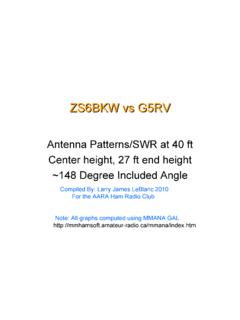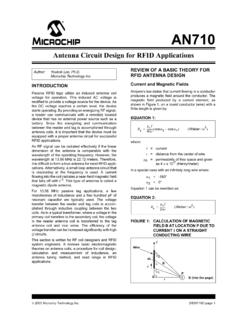Transcription of Computer Antenna Modeling Simplified – KE5KJD
1 Computer Antenna Modeling Computer Antenna Modeling Simplified KE5 KJDS implified KE5 KJDAn exposure to the benefits of Computer Modeling using from the Internet for the AARA Ham Radio Club - 2010 Antenna Modeling What is it? Antenna Modeling What is it?Computerized Antenna Modeling is evaluating the performance of a system that is governed by the laws of physics. Antenna - Modeling programs are Computer programs that use mathematics to calculate and predict the electrical performance of an Antenna . Modeling usually has its limitations, partly because the mathematical model that we have to describe it can almost never be described in the same detail as the real thing (and especially its environment), and partly because of numerical limitations in the calculating code used or imposed by the developer. The final limitation is the operator, who enters the data and who interprets the results. In all cases a good deal of knowledge and experience in the field of antennas is required in order to draw the correct conclusions and take the right decisions during the process of Modeling .
2 However almost anyone with a Computer and data entry skills can select an Antenna design of a given type and change it to match their constraints and view the results. Start With Simple Equations Start With Simple Equations Why Model AntennasWhy Model AntennasTo understand how antennas work. To verify designs from literature. To optimize a design for your particular needs (frequency, height, application). To create a new design. To compare one Antenna design against modify the resonant frequency of an existing understand the effects of a planned Antenna see the effects of varying the angle (horizontal, vertical) of a dipoleTo determine the feedpoint impedance around the chosen frequencyTo place the Antenna (s) at your see the Antenna radiation pattern and take off view induced currents in metal objectsTo avoid complex manual calculationsFor the pure joy of it .. Like working crossword Answered By ModelingQuestions Answered By Modeling1. What is the radiation pattern for a given Antenna at my location?
3 2. Will my roof, gutters and clothesline poles affect the pattern?3. What do I need to do to the Antenna to optimize it for my favorite portion of the band (phone, data, cw)?4. How much of the band can I use effectively with or without a How much of a change can I expect if I increase the height from 25 feet to 45 feet?6. What is the SWR curve over frequency look like at the Antenna ?7. What is the SWR curve look like at the transmitter end of my feedline?8. Can I place another Antenna on the same support without deteriorating the performance?9. Where should I place another Antenna structure in my yard to minimize its effects (or improve its effects)?10. What SWR at 10 feet results in a given SWR at 40 feet?11. How much of my power is actually delivered to the Antenna ?12. What losses are introduced by the cable and other elements?13. Which Antenna type should I put up in my situation?NOTE: Modeling can save money, time, and shoe Software Modeling WorksHow Software Modeling Works1.
4 Define the geometry of the Define the environment in which the Antenna Define the numerical evaluation parameters (if different from a base set)4. Select the center frequency for the initial Antenna Select the lower and upper bounds for the View the Make modifications, then rerun until you are satisfied with Sleep on it and start over the next Antenna Modeling programs have extensive libraries of standard Antenna designs to choose from, so #1 above is not so bad. Most have also tried to make the data entry as painless as possible, but most fall short of easily referencing Antenna elements and placement that the amateur radio operator would like. KE5 KJD adds his own elements to a basic library of Antenna parts and uses these to build new have options to automate step 7 using supplied modification rules and some definition of success . Parts of the Antenna ModelParts of the Antenna ModelParts of the Antenna ModelParts of the Antenna ModelParts of the Antenna ModelParts of the Antenna ModelWhich Program Do I Use?
5 Which Program Do I Use?1. NEC Numeric Electromagnetics Code2. NEC 2 Public Domain - Single diameter wires3. 4 NEC2 Free version of NEC 24. EZNEC, EZNEC Pro W7EL Active ham developer/Sales5. NEC 4 Latest version from Lawrence Livemore Labs ($250 License)6. MMANA GAL EZNEC with spreadsheet Antenna GAL ANA MININEC 3 and NEC2 calculations. Demo version only, in active MININEC versions are adequate for most applications. NEC 4 models most situations, including an accurate ground system. MMANA GAL does not have accurate results near ground but does include variable element diameters and tapered elements. NEC 4 has the most up to date features and is used by Antenna design should look up these programs on the internet if you need additional information. KE5 KJD uses MMANA GAL because it is free and does a reasonable job of calculating radiation Antenna Modeling ProgramMMANA Antenna Modeling ProgramAuthor: Makoto (Mako) Mori JE3 HHT 1999-2000 Gontcharenko Gary DL2KQ-EU1TT developed and released English versions of MMANA in 2001-2002.
6 Nobuyuki Oba JA7 UDE wrote an English user manual in 2001. Software beta testing was provided by a group of fellow amateurs. Cost: FreewareMMANA is an Antenna analyzing tool based on the moment method introduced in MININEC (Mini Numerical Electromagnetics Code) Version 3. MININEC should not be confused with NEC, which is a large Antenna analysis program written in FORTRAN and designed to run on main-frame computers. A graphical user interface also was added that makes MMANA much easier to use than MININEC version it was ported from. (Some portions of later versions of MININEC are written in FORTRAN.) MMANA/GAL Program FeaturesMMANA/GAL Program Features Both table-based and graphical-based editors for Antenna design and definition A 3-dimensional graphical Antenna viewer that shows Antenna elements, element current distributions, and the elemental segmentations used. A far field radiation viewer that shows both horizontal and vertical far field radiation patterns (MMANA GAL has 3-D far field display) A comparator that can be used to compare two or more computation results An Antenna element editor An Antenna wire editor Tools for defining combinations of pipe or tube elements with stepped diameters A user-customizable automatic Antenna optimizer capable of optimizing Antenna designs with respect to jX, SWR, Gain, F/B, Elevation, and Current An Antenna optimizer results display table with manual tuning capabilities Antenna frequency characteristics plotting An Antenna specification file generator Plus many other things, such as 3-dimensional Antenna rotation, Antenna stacking, and frequency scaling MMANA/MMANA-GAL DifferencesMMANA/MMANA-GAL DifferencesMMANA-GAL v v D viewer only in V Roof Effects on G5RV (Zack) Modeling Roof Effects on G5RV (Zack)
7 Roof and Antenna ModelAntenna PatternModeling My HF2V ButternutModeling My HF2V Butternut80/40 MVerticalDetail OfMatching Coils40 M40 M80 M80 M Matching CoilRadialsModeling My (Real) HF2V ButternutModeling My (Real) HF2V ButternutBypass Capacitor80 M Coil40 M CoilMatching CoilRadial SystemRadialGround Screen Impedance Matcher Ground Screen Impedance Matcher At each grid junction,each current will split based on impedance ratios. (Superposition)This is the ground radials for the Hustler 6 band My ZS6 BKW And W5 DXPM odeling My ZS6 BKW And W5 DXPC rossed DipolesFed with MeasuredLength of Ladder lineThen 50 Ohm Coax80/40 Coax40,20,17,12,10, Feed Effects* due to Metal GainMeasured W5 DXP CorrectionMeasured W5 DXP CorrectionOriginalW5 DXPC orrectedW5 DXPM easured W5 DXP CorrectionMeasured W5 DXP CorrectionOriginalW5 DXPC orrectedW5 DXPM easured W5 DXP CorrectionMeasured W5 DXP CorrectionOriginalW5 DXPC orrectedW5 DXPM odeling My 2 Meter 6 Element BeamModeling My 2 Meter 6 Element Beam2 M Vertical Antenna Patterns Over 4 Mhz Frequency Range2 M Vertical Antenna Patterns Over 4 Mhz Frequency RangeModeling 6 M, 2 M, 70 CM AntennaModeling 6 M, 2 M, 70 CM AntennaWell, as you can guess, the next step is to see if they will all work on a common boom.
8 This version has the 2M/70CM elements in a vertical configuration, which is appropriate for repeater significant interactions are observed with the three antennas except for 70CM effects from the 2m to the left is the patternOf the Moxon with all elementsIn place Not too SWR on 6 MetersAntenna SWR on 6 MetersAntenna SWR on 2 MetersAntenna SWR on 2 MetersAntenna SWR on 70 CMAntenna SWR on 70 CMModeling My 2-Element Phased VerticalModeling My 2-Element Phased VerticalGutter anddownspoutHurricane FenceHustler 6 Band Vertical Weston 4 Band VerticalReflector/DirectorButternut HF2V 80/40 VerticalVertical Beam Antenna Pattern on 20 MetersVertical Beam Antenna Pattern on 20 MetersVertical Beam Antenna Pattern on 40 MetersVertical Beam Antenna Pattern on 40 MetersVertical Beam Antenna Pattern on 80 Meters (Phased Feed)Vertical Beam Antenna Pattern on 80 Meters (Phased Feed)Evaluate Vertical Jumpers at Antenna Base to Resonate VerticalEvaluate Vertical Jumpers at Antenna Base to Resonate VerticalOne JumperFour Jumpers (Parallel)Bandwidth 493 KhzBandwidth 512 KhzSWR Min MhzSWR Min MhzModeling My Colinear VHF VerticalModeling My Colinear VHF VerticalAntenna designed by Don Murray W9 VECompare My Colinear With J PoleCompare My Colinear With J PoleReduces high angle radiationIncreased low angle gainModeling My Fat VHF DipoleModeling My Fat VHF Dipole2 in ODFoil OverPVCNote slow SWR ChangeSource Information And ReferencesSource Information And 1 1 Computer Antenna Modeling Computer Antenna Modeling Simplified KE5 KJDS implified KE5 KJDAn exposure to the benefits of Computer Modeling using from the Internet for the AARA Ham Radio Club - 2010 Archie asked me a few months ago if I would be interested in presenting some information to the club about Antenna Modeling .
9 Not being an expert in the subject, I chose the topic Computer Antenna Modeling Simplified , thinking that I could present material that I do understand and avoid any complicated questions on the subject. This entire presentation is available on the AARA Club site at topic has become a high interest topic in the last 10 years because the computers available for personal use have the capacity and speed to perform the many calculations that at one time were done is much easier to modify and test a Computer model than a full sized Antenna design, especially at the HF and lower HF typical PC of 1 GHZ and above has more processing power and memory than some of the supercomputers available only to research and government groups in the presentation will show that Modeling is one way to try out Antenna designs before building and testing doesn t take long to convince yourself that building antennas with software is more accurate, less time consuming and a heck of lot safer (and cheaper!)
10 Than the real thing. However, one must remember the objective --- to have an real Antenna system that will allow you to enjoy the hobby on an ongoing basis. 2 2 Antenna Modeling What is it? Antenna Modeling What is it?Computerized Antenna Modeling is evaluating the performance of a system that is governed by the laws of physics. Antenna - Modeling programs are Computer programs that use mathematics to calculate and predict the electrical performance of an Antenna . Modeling usually has its limitations, partly because the mathematical model that we have to describe it can almost never be described in the same detail as the real thing (and especially its environment), and partly because of numerical limitations in the calculating code used or imposed by the developer. The final limitation is the operator, who enters the data and who interprets the results. In all cases a good deal of knowledge and experience in the field of antennas is required in order to draw the correct conclusions and take the right decisions during the process of Modeling .







